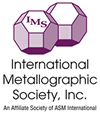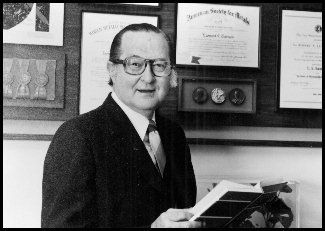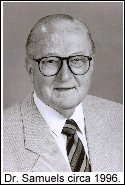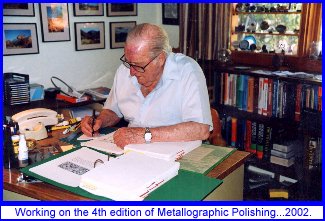
The Samuels Symposium on
Metallographic Sample Preparation
Quebec City, Canada
Convention Center

Dr. Samuels in his office in 1980.
 |
The Samuels Symposium on
|
|||
| Sunday, August 4, 2002
Quebec City, Canada Convention Center
|
 Dr. Samuels in his office in 1980. |
|||
|---|---|---|---|---|
|
|
||||
George VanderVoort, Chairman
This symposium is being held in honor of Dr. Leonard E. Samuels who has recently celebrated his 80th birthday. Many of us know Sammy through the third edition of his landmark book, Metallographic Polishing by Mechanical Methods, published by ASM in 1982. This book summarizes experiments in grinding and polishing made by Sammy and his colleagues over the past 50 years and provides the basis for much of our understanding of metallographic specimen preparation. Older IMS members know him personally as he attended quite a few of our meetings in the past. The Symposium will be held on Sunday, August 4, in the convention center and consists of the following lectures.
Len Samuels, 1980 recipient of IMS’s Henry Clifton Sorby Award, was born in Brisbane (Queensland), Australia, on February 28, 1922. He moved to Melbourne (Victoria) after grammar school and studied metallurgical engineering at the University of Melbourne. When World War II broke out, the Australian government instituted strict manpower rules requiring engineering students to continue their studies. In his third year (1942), Singapore fell to the Japanese and the government realized that it must increase its war production effort. The members of Len’s class were asked to volunteer part of their school year at the Munitions Supply Laboratories and to join the staff upon graduation. Over the years, this laboratory has gone through several name changes and is currently known as the Aeronautical and Maritime Research Laboratory (AMRL), Defence Science and Technology Organization, Australia Department of Defence.

In 1943, Len received his bachelor’s degree in Metallurgical Engineering and joined this lab. At that time, it was responsible for maintaining physical standards and for performing short-term research on problems related to defense equipment manufacture. AMRL was located, and still is, at Maribyrnong, a Melbourne suburb. But, in 1943, a branch was opened in Sydney (New South Wales), and Len was asked to join this facility. At that time, everything was in short supply. The Allied nations helped transfer technology and some of the needed equipment to produce locally what was needed.
By the end of WWII, Len was the leader of a branch of a large team of young physical metallurgists skilled in short term research and knowledgeable in advanced materials of that era. But, projects had to be converted to peaceful applications in useful areas. So, at first, they started developing their research skills in specific areas that were believed to be important for the future. One result was publication of numerous papers in peer-reviewed journals. In 1958, the University of Melbourne awarded Len their David Syme Research Prize and Medal, their most prestigious research award open to scientists from all disciplines. “Sammy” received his MS in 1955 and his DSc in 1959 from the University of Melbourne.
Sammy’s personal choice for research (he did this part time as he was in charge of the overall organization) was to develop simpler, more reliable, scientifically based methods of metallographic specimen preparation. Although limited use had been made with diamond abrasives in preparing sintered carbides as far back as the 1920s, Sammy was the first, in 1952, to publish a preparation system for general application based on diamond abrasives. His work introduced actual quantified data on material removal rates, rather than simply qualitative assessments. This interest led Sammy and his co-workers to examine the mechanisms of abrasion and polishing processes and their effects on surface structure, with the goal of establishing the principles that could be applied to reveal the correct microstructure as simply as possible. Introduction of artifacts during specimen preparation was a problem and some published studies were based on false conclusions due to their presence. Len and his group investigated a number of such cases, always trying to be constructive at the same time. This work lead to exploration of abrasive machining, machining in general, and studies of abrasive wear.

The parent laboratory in Maribyrnong did not follow the post-war research trend instituted by Sammy for the Sydney branch but continued to draw upon the technology accumulated during the war years. As a result, the laboratory slowly declined in quality and prestige. Subsequently, a new Chief Superintendent was appointed and Len was asked to join the parent laboratory and was promoted to Superintendent of the Metallurgy Division in 1962. The program was designed to support the purchase and manufacture of defense related equipment and to conduct vigorous research in chosen areas: mechanical metallurgy, machining, casting, welding, heat treatment, corrosion and surface protection, and projectile-armor interactions. This division grew to a staff of about 100 engineers and technicians, the largest in Australia. Supervising definitely curtailed Sammy’s time to conduct research, but he did manage to write several excellent books. His classic treatise, Metallographic Polishing by Mechanical Methods was first published in Australia in 1967. The third edition was published in 1982 by ASM and his fourth edition should be printed soon. In 1980, he published Optical Microscopy of Carbon Steels with ASM and, in 1999, its successor, Light Microscopy of Carbon Steels.
In 1981, he was appointed Chief Superintendent of AMRL and he remained in this position until he retired in 1983. At that time, the laboratory had a staff of about 800 in four scientific divisions. Sammy has remained active in retirement with more writing, for example, Metals Engineering: A Technical Guide, was published by ASM in 1988.
 Sammy has
received his share of honors over the years. Besides the Syme Award, he received
the Florence Taylor Medal of the Institute of Metals and Materials Australasia
in 1959, The Robert S. Leather Award of the American Electroplaters’
Society in 1960, and the Silver Medal of The Institute of Metals and Materials
Australasia in 1972. He is an ASM fellow, received the Sorby Award in 1980
(as mentioned above), and twice received the Buehler Best Paper Award for
the best publication in Metallography/Materials Characterization (1981 and
1992). Besides ASM, he is a fellow member of the Australian Academy of
Technological Sciences and Engineering, the Institution of Engineers, Australia,
and of the Institute of Metals and Materials, Australasia. He is also a member
of the Order of Australia.
Sammy has
received his share of honors over the years. Besides the Syme Award, he received
the Florence Taylor Medal of the Institute of Metals and Materials Australasia
in 1959, The Robert S. Leather Award of the American Electroplaters’
Society in 1960, and the Silver Medal of The Institute of Metals and Materials
Australasia in 1972. He is an ASM fellow, received the Sorby Award in 1980
(as mentioned above), and twice received the Buehler Best Paper Award for
the best publication in Metallography/Materials Characterization (1981 and
1992). Besides ASM, he is a fellow member of the Australian Academy of
Technological Sciences and Engineering, the Institution of Engineers, Australia,
and of the Institute of Metals and Materials, Australasia. He is also a member
of the Order of Australia.
As a personal note, Sammy is noted for his charming Auzzie humor and accent and his gracious manners. Listening to his lectures has always been a great treat for audiences. I am sure that I can speak for many “old time” IMS members when I say that it has been my personal good fortune to meet him several times in the US over the past thirty years; and, to have the opportunity to visit Len and his wife, Pat, three times at their home in Ashwood, a Melbourne suburb. I shall always cherish those moments. Unfortunately, Len does not think that he is up to the rigors of traveling from Australia to Quebec City, but he may be able to join us at his 80th birthday symposium by way of modern video technology.
George F. Vander Voort
Chairman, The Samuels’ Symposium on Metallographic Specimen
Preparation
Go to: |
[ASM] |
[Home] |
[Metallography Contest] |
[Sorby Award] |